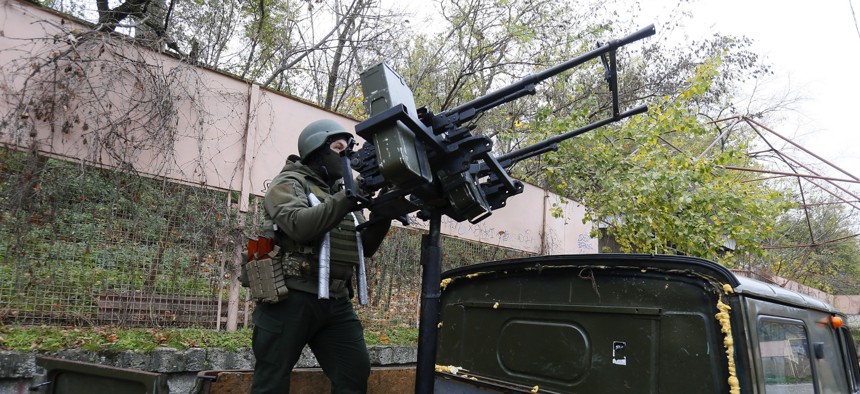
Ukrainian National Guardsmen developed an anti-drone machine gun in Mykolaiv. Vladimir Shtanko/Anadolu Agency via Getty Images
Counter-drone tech talk; Leonardo DRS merger closes; F-16 rolls from new plant, and more.
In late September, an NFL game between the Atlanta Falcons and Seattle Seahawks was delayed for about eight minutes while a small drone hovered over Lumen Field. One day earlier, the same thing happened nearby during a University of Washington football game.
Neither incident did more than disrupt a game, but both underlined security concerns about cheap, easy-to-use drones. Some 5,500 miles from Seattle, Russia and Ukraine are increasingly using kamikaze drones on the battlefield.
The proliferation of drones has prompted numerous companies to come up with ways to defeat them. At last month’s Association of the U.S. Army’s annual meeting in Washington, a bunch of new counter-drone tech was on display.
In recent years, the Pentagon’s counter-drone efforts have been piecemeal. In January, U.S. Special Operations Command awarded Anduril a contract that could be worth up to $1 billion; In October, the Army’s Counter Small Unmanned Aircraft Systems office approved counter-drone tech made by SAIC, Anduril, and Black Sage Technologies to protect military bases. This month, the U.S. Marine Corps asked companies to give them details about tech that could protect 33 installations: 20 in the United States and 13 overseas.
I recently chatted with Greg Fortier, SAIC’s vice president of Army solutions, about the company’s efforts in the field. Over the past decade, SAIC’s counter-drone tech has been used during the Olympics, global leaders summits, and most recently during the Artemis launch at Cape Canaveral.
“A lot of learning along the way and a lot of innovation along the way to really develop what we think is the only technology-agnostic counter-UAS system,” Fortier said.
SAIC says its tech can be tailored to defend anything from a stadium or a stretch of the border. The counter-drone systems detect, identify, track, and then defeat the nefarious drone in several ways. One is called AeroGuard, a drone that fires a net at the rogue drone and then carries it to the ground.
Other options include “high-powered microwave, a high-energy laser, or what have you,” Fortier said.
SAIC uses up to 14 vendors, depending on a customer’s needs, but it is evaluating dozens more, Fortier said. The company touts its open system, which allows it to easily add tailored tech developed by others. The system can be installed on a vehicle, a trailer, or a fixed location.
“We are working through laser integrations on vehicles and some other things and learning lessons along the way so that we can understand the requirements, understand the power draw and some of the other technical components associated with that,” he said. “But [the system is] very, very flexible; very, very modular; very, very scalable.”
During a demonstration at the Yuma Proving Ground earlier this year, SAIC’s system “demonstrated impressive effectors,” according to a Sept. 16 Army memo reviewed by Defense One. It was able to force a rogue drone to land using EnforceAir technology and also used the AeroGuard drone to chase down a threatening aircraft. Fortier said the company’s tech was “92 percent effective” during the Army trials.
Fortier said SAIC’s tech is unique in that one person can control the entire system from a single computer screen. The system can also be connected to military networks where it can share its data.
Like its competitors, SAIC sees counter-drone tech as a growth area. Fortier said the company will “continue to evolve our systems, continue to stick with the team, keep the team intact, and then continue to be innovative across our space, whether it be the various software tools that we can use, incorporating the AI and machine learning into the process.”
Welcome
You’ve reached the Defense Business Brief by Marcus Weisgerber. Hope you had a relaxing Thanksgiving break. Send along your tips, feedback, and holiday party invites to mweisgerber@defenseone.com or @MarcusReports. Check out the Defense Business Brief archive here, and tell your friends to subscribe!
JUST IN: The merger of Leonardo DRS and RADA Electronic Industries has closed, the companies announced this afternoon. The joint company will begin trading on the NASDAQ Tuesday morning and the Tel Aviv Stock Exchange on Wednesday.
We’re hitting the ground running this week with the much-anticipated B-21 stealth bomber unveiling on Friday evening. I’ll be in Palmdale, California, in the hangar when the sheet is finally pulled off the top-secret plane. Also, there will be a livestream of the event here.
Also, the Reagan National Defense Forum at the Ronald Reagan Presidential Library in Simi Valley, California, is on Saturday. My Defense One colleague Lauren Williams and I will be there, so make sure you say hello. The full agenda as of Monday is here. Scheduled to speak: All three service secretaries, four of the Joint Chiefs, four undersecretaries; and top executives form numerous defense companies.
The Navy says the Boeing-made High Altitude Anti-Submarine Warfare Weapon Capability, or HAAWC, has met the requirements for initial operational capability. The weapon allows the P-8 submarine hunter to fire MK 54 torpedoes “from near or below its cruising altitude,” according to Boeing. “The initial operational capability milestone marks the readiness of HAAWC for fleet introduction for the Navy and its international partners,” program manager Dewayne Donley said in a statement. “We’re excited to deliver greater flexibility and capability by way of higher-altitude launches from longer distances than previously possible.”
The first Block 70 F-16 has been built and painted at Lockheed Martin’s new production line in Greenville, South Carolina, Greg Ulmer, the executive vice president of the company’s Aeronautics business area, wrote on LinkedIn. Last year, the U.S. Air Force awarded Lockheed a contract to build Block-70 F-16s for Bahrain, Slovakia, Bulgaria, and Taiwan.




